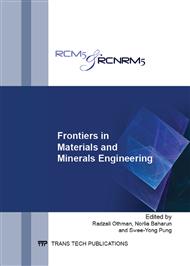[1]
D.W. Hutmacher, Scaffolds in tissue engineering bone and cartilage, Biomaterials. 21 (2000) 2529-2543.
DOI: 10.1016/s0142-9612(00)00121-6
Google Scholar
[2]
S. -H. Lee, H. Shin, Matrices and scaffolds for delivery of bioactive molecules in bone and cartilage tissue engineering, Advanced Drug Delivery Reviews. 59 (2007) 339-359.
DOI: 10.1016/j.addr.2007.03.016
Google Scholar
[3]
A.S. Posner, F. Betts, Synthetic amorphous calcium phosphate and its relation to bone mineral structure, Accounts of Chemical Research. 8 (1975) 273-281.
DOI: 10.1021/ar50092a003
Google Scholar
[4]
Z.L. Raguel, Apatites in biological systems, Progress in Crystal Growth and Characterization. 4 (1981) 1-45.
Google Scholar
[5]
L.L. Hench, Biorceramics: From concept to clinic, Journal of the American Ceramic Society. 74 (1991) 1487-1510.
DOI: 10.1111/j.1151-2916.1991.tb07132.x
Google Scholar
[6]
T.L.T. Kitsugi, T. Yamamuro, T. Nakamura, M. Oka, Transmission electron microscopy observations at the interface of bone and four types of calcium phosphate ceramics with different calcium/phosphorus molar ratios, Biomaterials. 16 (1995).
DOI: 10.1016/0142-9612(95)98907-v
Google Scholar
[7]
B.M. Tracy, R.H. Doremus, Direct electron microscopy studies of the bone-hydroxylapatite interface, Journal of Biomedical Materials Research. 18 (1984) 719-726.
DOI: 10.1002/jbm.820180702
Google Scholar
[8]
S.N. Bhaskar, J.M. Brady, L. Getter, M.F. Grower, T. Driskell, Biodegradable ceramic implants in bone: Electron and light microscopic analysis, Oral Surgery, Oral Medicine, Oral Pathology. 32 (1971) 336-346.
DOI: 10.1016/0030-4220(71)90238-6
Google Scholar
[9]
H. -W. Kim, S. -Y. Lee, C. -J. Bae, Y. -J. Noh, H. -E. Kim, H. -M. Kim, J.S. Ko, Porous ZrO2 bone scaffold coated with hydroxyapatite with fluorapatite intermediate layer, Biomaterials. 24 (2003) 3277-3284.
DOI: 10.1016/s0142-9612(03)00162-5
Google Scholar
[10]
S.F. Hulbert, F.A. Young, R.S. Mathews, J.J. Klawitter, C.D. Talbert, F.H. Stelling, Potential of ceramic materials as permanently implantable skeletal prostheses, Journal of Biomedical Materials Research. 4 (1970) 433-456.
DOI: 10.1002/jbm.820040309
Google Scholar
[11]
M.C. Azevedo, R.L. Reis, M.B. Claase, D.W. Grijpma, J. Feijen, Development and Properties of Polycaprolaction/Hydroxyapatite Composite biomaterials. Journal of materials science: Materials in medicine. 14 (2003) 103-107.
DOI: 10.1023/a:1022051326282
Google Scholar
[12]
V. Guarino, F. Causa, P.A. Netti, G. Ciapetti, S. Pagani, D. Martini, N. Baldini, L. Ambrosio, The Role of Hydroxyapatite as Solid Signal on Performance of PCL Porous Scaffolds for Bone Tissue Regeneration, Journal of Biomedical Materials Research Part B: Applied Biomaterials. 86 (2008).
DOI: 10.1002/jbm.b.31055
Google Scholar
[13]
H. -W. Kim, J.C. Knowles, H. -E. Kim, Hydroxyapatite/poly(ε-caprolactone) composite coatings on hydroxyapatite porous bone scaffold for drug delivery, Biomaterials. 25 (2004) 1279-1287.
DOI: 10.1016/j.biomaterials.2003.07.003
Google Scholar
[14]
V. Mourinño, A.R. Boccaccini, Bone tissue engineering therapeutics-controlled drug delivery in three dimensional scaffolds, Journal of the royal society interface. 7 (2010) 209-227.
DOI: 10.1098/rsif.2009.0379
Google Scholar
[15]
G. Ciaptti, L. Ambrosio, L. Savarino, D. Granchi, E. Cenni, N. Baldini, S. Pagani, S. Guizzardi, F. Causa, A. Giunti, Osteoblast growth and function in porous poly ε-caprolactone matrices for bone repair: a preliminary study, Biomaterials. 24 (2003).
DOI: 10.1016/s0142-9612(03)00263-1
Google Scholar
[16]
Y. -H. Koh, C. -J. Bae, J. -J. Sun, I. -K. Jun, H. -E. Kim, Macrochanneled poly (ε-caprolactone)/ hydroxyapatite scaffold by combination of bi-axial machining and lamination, Journal of Materials Science: Materials in medicine. 17 (2006) 773-778.
DOI: 10.1007/s10856-006-9834-1
Google Scholar
[17]
B. Rai, M.E. Oest, K.M. Dupont, K.H. Ho, S.H. Teoh, R.E. Guldberg, Combination of platelet-rich plasma with polycaprolactone-tricalcium phosphate scaffolds for segmental bone defect repair, Journal of Biomedical Materials Research Part A. 81A (2007).
DOI: 10.1002/jbm.a.31142
Google Scholar
[18]
C.G. Pitt, F.I. Chasalow, Y.M. Hibionada, D.M. Klimas, A. Schindler, Aliphatic polyesters. I. The degradation of poly(ϵ-caprolactone) in vivo, Journal of Applied Polymer Science. 26 (1981) 3779-3787.
DOI: 10.1002/app.1981.070261124
Google Scholar
[19]
T. Kokubo, H. -M. Kim, M. Kawashita, Novel bioactive materials with different mechanical properties, Biomaterials. 24 (2003) 2161-2175.
DOI: 10.1016/s0142-9612(03)00044-9
Google Scholar
[20]
G. Tripathi, B. Basu, A porous hydroxyapatite scaffold for bone tissue engineering: Physico-mechanical and biological evaluations, Ceramics International. 38 (2012) 341-349.
DOI: 10.1016/j.ceramint.2011.07.012
Google Scholar
[21]
J.R. Jones, L.L. Hench, Regeneration of trabecular bone using porous ceramics, Current Opinion in Solid State and Materials Science. 7 (2003) 301-307.
DOI: 10.1016/j.cossms.2003.09.012
Google Scholar
[22]
C. Vitale-Brovarone, E. Verné, L. Robiglio, P. Appendino, F. Bassi, G. Martinasso, G. Muzio, R. Canuto, Development of glass–ceramic scaffolds for bone tissue engineering: Characterisation, proliferation of human osteoblasts and nodule formation, Acta Biomaterialia. 3 (2007).
DOI: 10.1016/j.actbio.2006.07.012
Google Scholar
[23]
Y. Chen, L. Zhang, X. Lu, N. Zhao, J. Xu, Morphology and Crystalline Structure of Poly(e-Caprolactone) Nanofiber via Porous Aluminium Oxide Template, Macromol. Mater. Eng. 291 (2006) 1098-1103.
DOI: 10.1002/mame.200600134
Google Scholar


